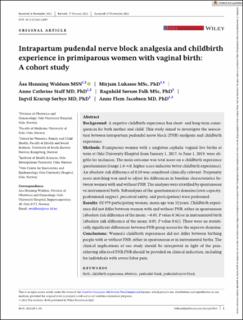| dc.contributor.author | Waldum, Åsa | |
| dc.contributor.author | Lukasse, Mirjam | |
| dc.contributor.author | Staff, Anne Cathrine | |
| dc.contributor.author | Falk, Ragnhild Sørum | |
| dc.contributor.author | Sørbye, Ingvil | |
| dc.contributor.author | Jacobsen, Anne Flem | |
| dc.date.accessioned | 2023-08-25T13:55:57Z | |
| dc.date.available | 2023-08-25T13:55:57Z | |
| dc.date.created | 2023-01-02T18:23:46Z | |
| dc.date.issued | 2022 | |
| dc.identifier.citation | Waldum, Å. H., Lukasse, M., Staff, Anne C., Falk, R. S., Sørbye, Ingvil K. & Jacobsen, A. F. (2023). Intrapartum pudendal nerve block analgesia and childbirth experience in primiparous women with vaginal birth: A cohort study. Birth, 50(1), 182-191. | en_US |
| dc.identifier.issn | 0730-7659 | |
| dc.identifier.uri | https://hdl.handle.net/11250/3085847 | |
| dc.description.abstract | Background: A negative childbirth experience has short- and long-term consequences for both mother and child. This study aimed to investigate the association between intrapartum pudendal nerve block (PNB) analgesia and childbirth experience.
Methods: Primiparous women with a singleton cephalic vaginal live births at term at Oslo University Hospital from January 1, 2017, to June 1, 2019, were eligible for inclusion. The main outcome was total score on a childbirth experience questionnaire (range 1.0–4.0, higher score indicates better childbirth experience). An absolute risk difference of 0.10 was considered clinically relevant. Propensity score matching was used to adjust for differences in baseline characteristics between women with and without PNB. The analyses were stratified by spontaneous vs instrumental birth. Subanalyses of the questionnaire's domains (own capacity, professional support, perceived safety, and participation) were performed.
Results: Of 979 participating women, mean age was 32 years. Childbirth experience did not differ between women with and without PNB, either in spontaneous (absolute risk difference of the mean: −0.05, P value 0.36) or in instrumental birth (absolute risk difference of the mean: 0.03, P value 0.61). There were no statistically significant differences between PNB group scores for the separate domains.
Conclusions: Women's childbirth experiences did not differ between birthing people with or without PNB, either in spontaneous or in instrumental births. The clinical implications of our study should be interpreted in light of the pain-relieving effects of PNB.PNB should be provided on clinical indication, including for individuals with severe labor pain. | en_US |
| dc.language.iso | eng | en_US |
| dc.rights | Navngivelse-Ikkekommersiell 4.0 Internasjonal | * |
| dc.rights.uri | http://creativecommons.org/licenses/by-nc/4.0/deed.no | * |
| dc.title | Intrapartum pudendal nerve block analgesia and childbirth experience in primiparous women with vaginal birth: A cohort study | en_US |
| dc.type | Peer reviewed | en_US |
| dc.type | Journal article | en_US |
| dc.description.version | publishedVersion | en_US |
| dc.rights.holder | © 2022 The Authors. | en_US |
| dc.source.pagenumber | 182-191 | en_US |
| dc.source.volume | 50 | en_US |
| dc.source.journal | Birth | en_US |
| dc.source.issue | 1 | en_US |
| dc.identifier.doi | https://doi.org/10.1111/birt.12697 | |
| dc.identifier.cristin | 2099177 | |
| cristin.ispublished | true | |
| cristin.fulltext | original | |
| cristin.qualitycode | 1 | |

